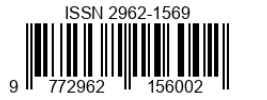Waktu Dan Jarak Efektif Penyinaran Sinar Ultraviolet Pada Mikroba Udara Laboratorium
DOI:
https://doi.org/10.57214/jusika.v5i1.470Keywords:
Distance, Settle Plate, UV Light, Exposure TimeAbstract
Ultraviolet light is commonly used as a laboratory sterilization method to complement chemical sterilization. Until now, there has been no standard reference for the use of exposure time and exposure distance that can be effectively used for sterilizing laboratory rooms. Based on this, it is necessary to conduct this research to test the effectiveness of ultraviolet irradiation in the laboratory with varying exposure times, including 0.5, 1, 1.5, and 2 hours with an irradiation distance of 1, 1.5, and 2 meters. This experimental research was conducted at the Medical Laboratory of the Mangunwijaya Catholic Polytechnic of Medical Laboratory Technology Program. Capture of airborne microbes using the settle plate method. The results showed that the percentage reduction in the number of microbes before and after irradiation was 96.30, 62.97, 85.18, and 59.26 CFU/m3, respectively, for exposure time 0.5, 1, 1.5, and 2 hours, while the percentage decrease in the number of microbes for distance 1; 1.5; and 2m is 66.67; 67.74; 64.71 CFU/m3. The conclusion was that the adequate time to reduce the number of air microbes was 0.5 hours, while the effective distance was 1.5m.
References
Andersen B.M., Banrud H.. Boe E., Bjordal O., Drangsholt F. (2006). Comparison of UV C Light and Chemicals for Disinfection of Surfaces in Hospital Isolation Units. Infection Control and Hospital Epidemiology. Vol 27. no 7. DOI: 10.1086/503643
Ariyadi T. dan Dewi S.S. (2009). Pengaruh Sinar Ultra Violet terhadap Pertumbuhan Bakteri Bacillus sp Sebagai Bakteri Kontaminan. Jurnal Kesehatan 2(2). http://Jurnal.unimus.ac.id
Cahyonugroho O. H. (2010). Pengaruh Intensitas Sinar Ultraviolet dan Pengadukan terhadap Reduksi Jumlah Bakteri E.coli. Jurnal Ilmiah Teknik Lingkungan 2(1). https://core.ac.uk/download/pdf/12216682.pdf
Casini B., Tuvo B., Cristina M.L., Spagnolo A.M.. Totaro M., Baggiani A., and Privitera G.P. (2019). Evaluation of an Ultraviolet C (UVC) Light-Emitting Device for Disinfection of High Touch Surfaces in Hospital Critical Areas. Int. J. Environ. Res. Public Health. 16. 3572; doi:10.3390/ijerph16193572
Febriyanti N., Sutomo AH. (2013). Pengaruh Variasi Waktu Sterilisasi Dengan Sinar Ultra Violet Terhadap Angka Kuman Udara Ruang Operasi RSUD Brigjend. H. Hasan Basry Kandangan Provinsi Kalimantan Selatan. Tesis. S2 Ilmu Kesehatan Masyarakat. UGM
Havill N.L., Moore B.A., Boyce J.M. (2012). Comparison of the Microbiological Efficacy of Hydrogen Peroxide Vapor and Ultraviolet Light Processes for Room Decontamination. Infection Control and Hospital Epidemiology. Vol. 33. no. 5. DOI: 10.1086/665326
Katara G., Hemvani N., Chitnis V. (2008). Surface Desinfection By Exposure To Germicidal UV Light. Indian Journal of Medical Microbiology 26(3) : 241-42. DOI: 10.4103/0255-0857.42034
Konieczny, Radziejewska C., Mroczek, and Dziedzic. (2016). Analysis Of Air Quality In selected Areas Of A Poultry Processing Plant With The Use Of A Microbiological Air Sampler. Journal Of Poultry Science. 18 (3). 401-406. https://doi.org/10.1590/1806-9061-2015-0156
Lomrah S. (2017). Pengaruh Cahaya Ultraviolet C dan Kelembaban Udara (RH) Terhadap Jumlah Bakteri Eschericia coli pada Kulit Sepatu. Skripsi. Universitas Islam Negeri Maulana Malik Ibrahim: Malang.
Napoli C., Marcotrigiano V., and Montagna M.T. (2012). Air Sampling Procedures To Evaluate Microbial Contamination: A Comparison Between Active And Passive Methods In Operating Threatres. BMC Public Health. 12 (594). https://doi.org/10.1186/1471-2458-12-594
Peraturan Pemerintah RI No. 41 tahun 1999 Tentang Pengendalian Pencemaran Udara.
Permenkes RI, 1998. KEPMENKES.RI.No 261/MENKES/II/1998 tentang Standar Baku Mutu Udara Dalam Ruangan.
Permenkes RI, 2004. Kepmenkes Nomor 1204/Menkes/SK/X/2004 tentang Persyaratan Kesehatan Lingkungan Rumah Sakit.
Prathab, A.G., Lalitha, C. (2012). Microbiological Surveillance of Air Quality in Operation Theaters-Comparison of the Conventional Settle Plate Techniques vs Use an Air Sampling Device. Journal of Evolution of Medical and Dental Sciences. Vol 1 Issue 4. Bangalore. DOI: 10.14260/jemds/60
Sabharwal. R.. and Sharma. R. (2015). Estimation of microbial air contamination by settle plate method: are we within acceptable limit. SAJB. 3 (8): 703-707.
Sarinaningsih. (2018). Pengaruh Intensitas Lama Waktu Penyinaran Dan Posisi Sumber Sinar Ultraviolet Terhadap Reduksi Jumlah Bakteri E.coli pada Air Sumur. Mataram : Universitas Mataram.
Suharyono A.S., Erna M., dan Kurniadi. M. (2009). Pengaruh Sinar Ultra Violet Dan Lama Penyimpanan Terhadap Sifat Mikrobiologi dan Ketengikan Krem Santan Kelapa. AGRITECH 29 (3). https://doi.org/10.22146/agritech.9704
Waluyo R.A., Cahyono T. (2016). Efektifitas Sterilisasi Menggunakan Ultraviolet (UV) Pada Ruang Perawatan Di Rumah Sakit Umum Daerah Banyumas Tahun 2016. Jurnal Kesehatan Lingkungan. Poltekes Semarang: Semarang
Wedum A.G., Hannele. E., Philips. G.B. (1956). Ultraviolet Sterilization in Mircobiological Laboratories. Public Health Reports. Vol 71 No.4. PMCID: PMC2031103
Yang J., Wu U., and Tai.H. (2019). Effectiveness of an Ultraviolet-C Disinfection System For Reduction Of Healhcare-Associated Pathogens. Journal of Microbiology. 52. 487-493. DOI: 10.1016/j.jmii.2017.08.017








